Welcome to another session of Coasters101! Have you always wondered what type of calculations and mathematics engineers must do to design a roller coaster? Today, we are going to talk about the physics of roller coasters and run a few calculations in order to compute:
- mass of train
- lift incline length
- force required to pull the train up the lift
- time required to reach the top of the lift
- maximum speed of the train
- radius of the bottom of the first drop to limit g-forces
Please keep in mind that everything is generally simplified. Please comment if you have any questions!
First, draw a quick sketch of the center-line of your intended layout. Since this is my first attempt, I will make it rather simple. I will use Excel for calculations and a CAD program for drawing (though not required). I plan on linking the two together later on. There are a few basic parameters I decide to start out with: height of the station track from the ground is ten feet or 3.048 meters, height of the first hill is 120 feet or 36.576 meters, and the angle of the lift is at 42 degrees. Pictured below is my first quick sketch.
Now, it’s time to start some calculations. Let’s begin by calculating the force needed to pull the train up the lift hill incline and thus the power needed for the motor. In order to so, we need to estimate the maximum mass of a fully loaded train to ensure our lift hill motor can pull even the heaviest train of gravy loving coaster enthusiasts up the massive hill. We will plan on having a six car train. Each car holds two riders at 100 kg each, for a maximum mass of 735 kg (535 kg car + 2 x 100 kg riders). Therefore, the fully loaded coaster train will have a total mass of 4500 kg (about 10,000 pounds).
We selected the angle of the lift to be at 42 degrees. This means that the train is going to be pulled up vertically a distance of 36.576m-3.048m=33.528m. The length of the incline will be 33.528m/sin(42)=50.106m.
We will finish calculating the force required to pull the train up the incline. There are two other assumptions we will make at this point: the velocity of the train as it exits the station and the velocity at the top of the lift hill. The velocity coming out of the station will be 10mph or 4.4704 m/s. The speed at the top of the lift will be 18mph or 8.04672 m/s.
Energy is never destroyed, it is simply transferred from one body to another. Thus, we use an energy balance equation:
Kinetic Energy + Potential Energy + Work = Kinetic Energy + Potential Energy
Which is also written as: KE1 + PE1 + W = KE2 +PE2
Kinetic energy is a function of the velocity (KE=(1/2)mv^2). Potential energy is a function of the height (PE=mgh). Work=Force*distance.
Substitute the KE, PE, and W equations into our energy balance equation and we get this resulting equation:
(1/2)mv^2 + mgh + Fd = (1/2)mv^2 + mgh
Now we can insert our values and solve: .5(4500)(4.4704^2)+4500(9.8)(3.048)+F(50.106)=.5(4500)(8.046^2)+4500(9.8)(36.576)
F=31,518.8 N of force or 7085.708314 lbsf. Now we know how big of a motor we will need. One detail to note, we did not include the mass of the lift hill chain in our calculation.
How much time will it take for the train to reach the top of the lift hill? The acceleration of the train can be found using this equation: (vf)^2=(vo)^2+2ad Inserting our values: (8.04672)^2 (4.4704)^2+2(a)d Now solve for a and we get 0.45 m/s^2.
Next, use this equation to compute the time: Vf=Vo+at. Input values and solve for t. =(8.05-4.47)/0.45=8.01 sec. That’s pretty quick for a lift hill but it is only going up one hundred feet and at a 42 degree angle.
Now it’s time to calculate the maximum velocity of the ride. Since the 1st drop is the longest, the velocity at the bottom will be the greatest. Energy relationships will be used to calculate the velocity: KE1+PE1=KE2+PE2
.5mv1^2+mgh=.5mv2^2+mgh
Solve for v2 and we get 27.42 m/s or 61.34mph!
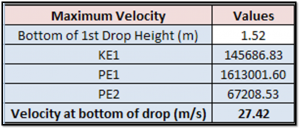 Finally, we want to figure out how what the radius of the curve of the bottom of the first drop should be in order to keep the g forces felt by the riders to be 2.5 g’s or less.
Finally, we want to figure out how what the radius of the curve of the bottom of the first drop should be in order to keep the g forces felt by the riders to be 2.5 g’s or less.

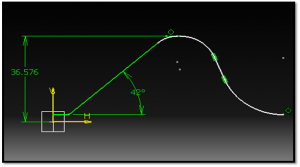
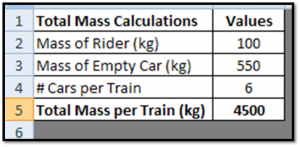
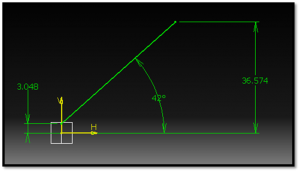
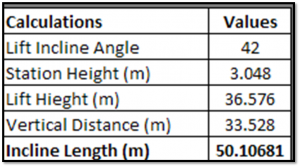
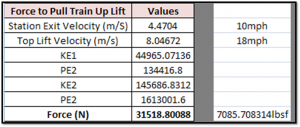

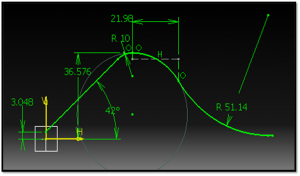
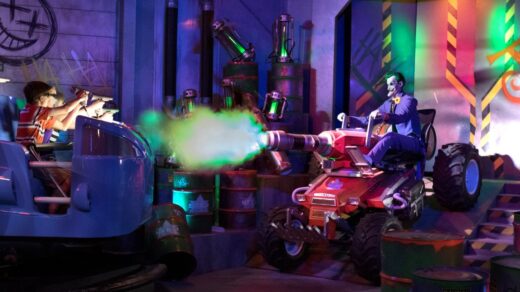
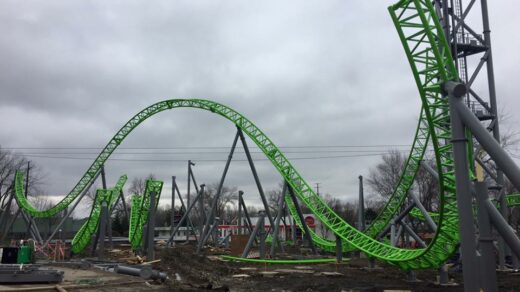
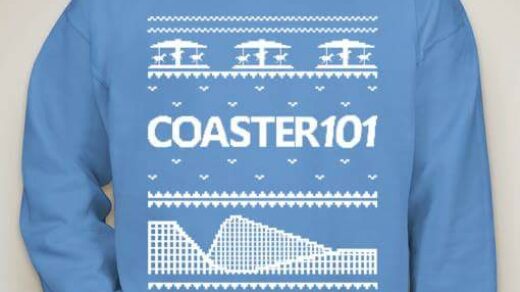









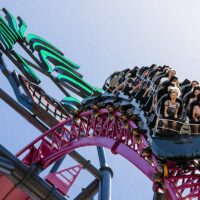
Wow – it’s not as easy as Roller Coaster Tycoon makes it out to be! Great article.
Thanks so much for creating all these articles!!
They were extremely helpful for a physics project, especially the article on banking turns and calculating the ideal banked turn!!!
Keep the great work coming!
Thanks so much,
Ryan
This site is really helpful!
I am working on a project for my school, but I have a question:
about the radius of the drop, what do you mean by G’s=Acentripetal/9.8?
What exactly is Acentripetal?
Thx
Really helpful! though, which is the custom friction a roller coaster normally has? thank you!
Hello, I am looking for help of how to calculate acceleration of millennium roller coaster using mathematics. Thanks